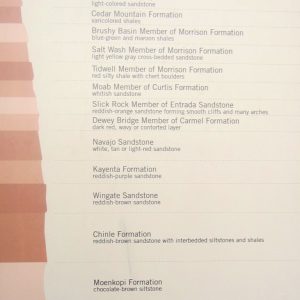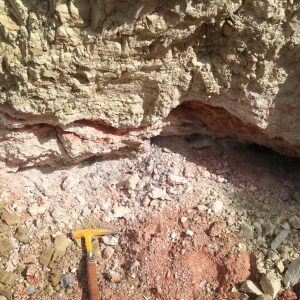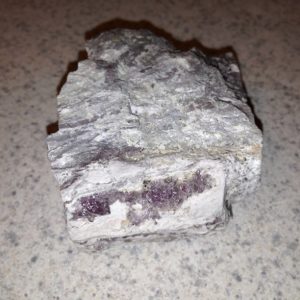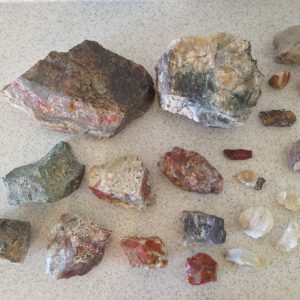A month has passed here in Las Cruces, NM and it’s made a world of difference. The sizzling, dry, fry-an-egg-on-the-asphalt heat has ended and the monsoon season has swept in in all its humid, thundering glory. While most of the country languished under a heat spell I laughed evilly at our good fortune of days in the high 80s! (Sorry, rest of country). Grasses and wildflowers are pushing themselves out of the soil and the ocotillos have leafed out. Green! Praise Gaia! Eli and I had been feeling somewhat pathetic about our two seed collections, but realized that the record number of collections for Las Cruces teams in July WERE only two. Onto brighter, greener things in August!
Besides the collections, we’ve had a few other interesting endeavors. Mike, our mentor, has been our guide on a grand tour of New Mexico! Using our GIS greenness index coupled with continuously updated precipitation data we’ve been to the Bootheel, Otero Mesa, Socorro, the plains of Augustine, Carlsbad, and Lordsburg (and everywhere in between) to monitor possible collections and look for green spots. I’ve learned that there is quite a formula to finding seeds: knowing what species are where, utilizing records of past collection locations and dates, monitoring rainfall and greenness, and scoping out locations while indulging in the finest gas station junk food.
In addition to getting a lay of the land, I’ve learned quite a bit about the multi-faceted nature of the BLM. Ranching on public lands is widespread throughout New Mexico and range management specialists appear to make up the majority of the BLM staff. If not managed properly, cattle can graze an allotment down to the dirt and the land suffers from erosion and invasion from unpleasant, inedible plant species. Especially in years of drought, like the last three in New Mexico, many ranchers let their stressed cattle overgraze public lands to the chagrin of many BLMers and the public. It’s annoying and depressing to drive through a dust storm and realize “there goes the topsoil” of the nearby field.
Another large stakeholder in public lands is the oil and gas industry. We just drove through a huge oil and gas field in Carlsbad first developed about seventy years ago. It’s a dramatically altered landscape, with wells and grasshopper-like pumps chugging away as far as the eye can see. Of course it’s not a beautiful sight, and one could easily say “This is horrible! Oil and gas development is horrible for the ecosystem!”. But I recognize the BLM’s efforts to keep the drilling concentrated when in theory, there could be wells spread out all over public lands. And as long as consumers demand petroleum and gas, someone has to provide them.
Also, we recently went to a meeting at the Santa Fe State Office where a private company (or mash of a few companies) was pitching its skills and resources in performing habitat restoration with native plant materials. It was incredibly interesting to hear the about their network of professionals (biologists, archeologists, landscape architects, etc.) and access to dozens of small nurseries focused on growing native, to-order plants for restoration. There were talks of restoring a farm in northern New Mexico as a demonstration garden focusing on restoration techniques and possibilities that the public and private sector could visit and reference. All in all, quite a few exciting things could be happening in terms of restoration in the near future.
One other thing from our trip to Santa Fe stuck out- I overheard a manager say, “If they aren’t mad at us-we obviously haven’t done our job!” He was jokingly referencing the difficulty in managing various stakeholders and their desires for the use of public lands. The interests of ranchers, energy companies, and recreation enthusiasts (and more) seem to rarely coincide (obviously). The BLM’s role in crafting use plans for its millions of acres of lands never completely pleases any stakeholder. But I can attest to the fact that BLMers are reasonable human beings who have to make tough calls when caught between various powerful interest groups.
On a more personal note, the last month has brought some difficulties as well. It’s hard to shift from college and being surrounded daily by friends to a completely new place and atmosphere. And other things are difficult too, like why won’t mom and dad pay my rent anymore?! (Haha, just kidding mother) My and Eli’s little isolated casita at the base of the Organ Mountains is gorgeous, but offers little possibility for human interaction. I’m starting to practice my harmonica, making epic desserts, planning cheese and bread-making, writing letters (oh my goodness people still do that?!), and enjoying every million-dollar sunset. It’s quite a change, but a good one and I’m sure it will only get better.
PS- Coolest place ever- the Very Large Array in the Plains of Augustine- makes me wish I was an astronomer!

The eensy weensy VLA (from far away)
Till August,
Kate





